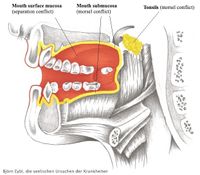Mouth and pharynx surface mucosa
Also see: mouth submucosa, tonsils, salivary glands, salivary ducts, oesophagus, upper 2/3
Sensitivity follows the gullet mucosa pattern.
Whether it involves the left or right side of the mouth depends on biological laterality.
Themes
Something to do with the function of the lips, mouth or tongue.
Realistic
- Wanting to have contact with something that goes in the mouth, for example, a candy (child), a certain supplement that one cannot afford.
- Not wanting a contact, such as losing your driver's license because of a alcohol test.
Metaphorically:
- Not being able or allowed to say something
- I couldn't say it.
- It's on the tip of my tongue...
- I wish I wouldn't have said it.
- What passed my lips hurt the other.
CA phase
Cell decrease in mouth surface mucosa; larger oral cavity.
Biological purpose
Being able to better feel what goes into the mouth.
Symptoms
Aphthous ulcers. Painful sores, like craters. The more intensive the conflict of the longer it lasts, the more painful it becomes.
PCL phase
Rebuilding cells of the oral mucosa.
Symptoms
Gingivitis. Swelling, possibly tired and listless, no pain. Often accompanied by paradontitis.
When the tongue is involved: typical "strawberry"-tongue in scarlet fever.
Scarlet fever is a combination of conflicts: an ugly separation involving the lower part of the epidermis (outer skin) + a "tongue conflict": the child wants something but doesn't get it.
Also metaphorically: children put everything in their mouths, so they want to experience something (put it in their mouths) and they cannot, should not or are not allowed to.
EC
Strong pains, bleeding.



